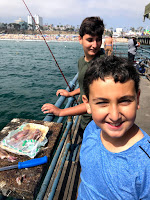The frozen squid was tough to deal with. The insides were too frozen, which made them mushy and useless, and the outer part, the skin, was slimy and slippery. Regardless, I managed to tip each hook on the sabiki rig with a strip of squid before putting a bigger piece onto rental rod. Very soon after we dropped the baits, we felt nibbles. Last year, my brother and I had come to the pier, and we bought shrimp for bait. Although we felt fish, most likely Mackerel, nibbling our baits the whole time, the softness of the frozen shrimp made it easy for the fish to take the bait off without getting hooked. This time, we learned from our mistakes and used tougher squid bait, which stays of the hook much easier. The change in baits proved to work, because not long after we started feeling nibbles, I saw the line move out to sea, away from the pier. I reeled in the line, and gave it to my brother to finish the job and bring the fish up. We had caught the first fish of the day, a Pacific Mackerel. This was not the first time I had caught this fish. Pacific Mackerel, or Chub Mackerel are very common all over California. It was a nice catch, and we were happy to get on the board so early.
After we caught the first fish, the nibbles seemed to slow down. We casted in different spots, but nothing changed. After a while, Jacob, my brother, and I decided to chum the water with our squid, as we had way too much bait to use in 2 hours of fishing. We cut up the bait, threw it out into the sea, and, sure enough, the squid had brought a school of fish to the surface! I started to jig the sabiki rod and Jacob casted the lighter dropper loop past the school, so he could reel the bait right into the school. The fish were nibbling, but the current had taken the chum, and the school, out too far in the pilings. I had already lost a hook back in the pilings when I decided to fish on the other side of the deck, under the pier. I told Jacob to cut some more squid and to throw it out into the Ocean side, North, so that the current would take the chum and the school into our lines. The plan worked! As I was jigging the sabiki rig in the school, a fish bit one of the hooks! I brought in the feisty fish and made sure to bring it over the railing as fast as possible. I didn't want to lose this fish. On the deck, I realized that I had just caught a new species! After researching the fish, I found out that it was a California Salema, Xenistius californiensis. It is a schooling grunt commonly found in Southern California. I was really excited to end the day with a new species!
It was a fun day out on the water with my dad and brother, and I was happy with the results. The fish may not have been too big, but as a multi species angler and lifelister, I respect every fish I catch. After all, a fish is a fish, and we achieved our goal of catching them. One of my favorite things about fishing is how it allows one to experience, learn about, and appreciate our waters and marine ecosystems. Catching a new fish in new waters is always a really cool experience that gives one a greater appreciation for the diversity of the waters that they are fishing and they fish for which they are fishing. It's really fun to keep track of the fish you have caught before, and to set out to catch new ones.
Anyways, like most fishing trips, we learned a lot from this one. It's no secret that current and positioning when chumming means everything when trying to bring fish to your bait, and we used this method to catch ourselves a new species. It was great to be fishing again. Stay tuned, and Tight Lines!












